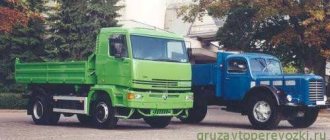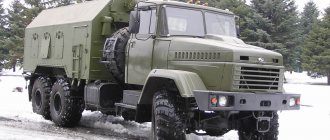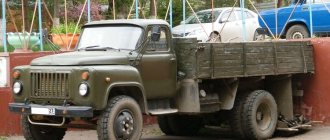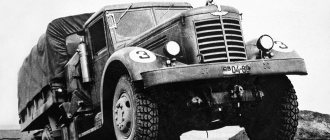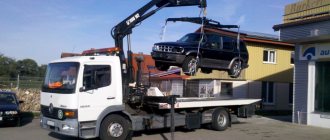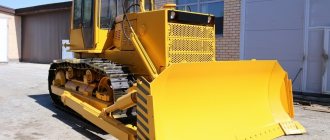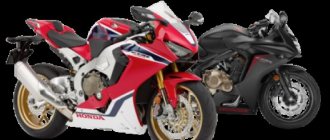Firstborn
Mikhail Sokolov, photo from the archives of MAZ OJSC, author, Alexander Novikov and Sergei Andreev
Exactly 55 years ago, the first serial heavy-duty all-wheel drive MAZ-501 rolled off the assembly line in Minsk.
In the early 1950s, the Minsk Automobile Plant was actively developing various versions of the basic 7-ton MAZ-200 (originally the Yaroslavl YaAZ-200). In particular, in 1951 they began developing the MAZ-501 (4x4) all-wheel drive onboard vehicle, intended primarily for the army. The model received a transfer case and a front drive axle, an onboard platform of the “200G” type, but the rear wheels with the usual tire size 12.00-20 remained dual-pitch. The presented samples did not make a proper impression on the main customer, and the transport workers were not interested in them either. The only ministry that seriously seized on this machine was the USSR Ministry of Forestry, which was in dire need of powerful timber carriers.
Minsk residents were offered, according to the “lesprom” specifications, to create a full-fledged specialized timber carrier with a bunk and a trailer, designed for exporting timber in assortments and logs up to 35 m long using a trailer, with a total load capacity of the road train of 15 tons, since before that timber in the USSR was exported mainly to standard flatbed trucks with platforms replaced by bunks during operation.
Soon, together with TsNIIME, industry-specific adjustments were made to the development of the 501st, and in November 1953, the first prototypes of the timber carrier were built, which over the next year and a half underwent a full cycle of comprehensive tests.
Chassis Features
MAZ-501 became the first domestic car with permanent all-wheel drive, since off-road mode was planned for it as standard. The designers of the plant, led by the leader in “all-wheel drive” A.Kh. Lefarov, in addition to the 5-speed gearbox from the MAZ-200, equipped the “501st” with a 2-speed transfer case (TC) with both reduction gears.
The front axle was also original, consisting of a load-bearing I-beam steel beam, in front of which a special small-sized central gearbox was mounted (a pair of bevel gears with spiral teeth and a cross-axle differential of the ZIS-150 type), which was shifted to the left relative to the longitudinal axis of the machine in order to be compactly placed between the frame spar and the engine crankcase. From the gearbox, the axle shafts in thin-walled protective tubes went to the final drives (cylindrical pairs of spur gears), located behind the spring platforms. This unconventional design was dictated by the limitation of the height of the tractor, since when installing a front drive axle with a double gearbox (similar to the rear one), the “501st” would “grow” by 400 mm compared to the MAZ-200, which was undesirable (high center of gravity and loading height), but here its growth was reduced to 170–200 mm. By the way, increasing the gap between the wheels and wings also made it easier to access the steering mechanism, rods and shock absorbers.
The total gear ratio of the front axle (as well as the rear final drive from MAZ-200V and 200G) was 9.81. To turn the front wheels, fairly reliable double universal joints and king pins on tapered roller bearings were used. The rear axle came from the MAZ-200 almost unchanged.
A cylindrical center differential of the planetary type asymmetrically transferred 2/3 of the torque to the rear axle and 1/3 of the torque to the front axle, compensating for its dispersion during maneuvering. To overcome slippery areas, there was a full mechanical differential lock mode (two types - manual or self-closing).
The engine, along with the clutch and gearbox, was borrowed from the MAZ-200. The frame, compared to the “200”, was significantly strengthened. Having raised it by 170 mm, I had to change the rear spring brackets. In addition to reinforced springs (11 leaves each), double-acting hydraulic shock absorbers were introduced into the front suspension.
The steering is also from the “200”, but with the introduction of rolling bearings, which made it easier to control. Stamped disc wheels with five small windows were identical to Minsk and Yaroslavl trucks. The most common tread pattern for tires 12.00-20 with a nominal pressure of 4.5 atm for the MAZ-501 was “straight herringbone” (“ground grip”). Two “spare wheels” were attached behind the cabin on steel holders, and their lowering and lifting were carried out by a special cable device.
The 225 liter fuel tank (also from the MAZ-200), located on the frame on the right, was covered with a metal grate from below, and from above by a loading platform deck, so when refueling, to access the tank neck, you first had to open the deck hatch.
In addition to the standard electrical equipment, the MAZ-200 “501st” was equipped with a rotating headlight to illuminate the loading area; it was located on the rear left edge of the cabin. Mounted on a galvanized stand, it could rise to a height of 0.5 m, rotate 360° and tilt. The rear light and license plate were installed next to it, under the cab roof.
At the rear of the frame, a traction beam was mounted with a system of holes in the arms for attaching a possible cross release coupling. The 2400x1150 mm bunk with folding racks, shifted 250 mm forward from the rear axle (for better weight distribution on the axles), was rotated on its own frame by 35° in each direction, and in the non-working position it was fixed slightly obliquely to reduce the overall width. In addition, a lattice safety fence made of angle iron, mounted on the frame, was installed behind the cabin.
Samples of MAZ-501 were tested at the Cherven Timber Industry Enterprise (LPH) TsNIIME. The car confidently moved on all types of roads, off-road, and snow up to 0.5 m. Based on the test results, the interdepartmental commission concluded that in terms of load capacity, cross-country ability and traction qualities, the MAZ-501 fully meets the requirements, and in terms of efficiency it is significantly superior to all vehicles used until. The first serial timber truck MAZ-501, as part of a pilot production batch, rolled off the main assembly line of the plant on December 18, 1955, and the following year mass production began, which lasted almost 10 years.
MAZ 103 buses and model configurations
The model range of MAZ 103 buses includes configurations with the addition of three characters after the main model name, for example, the MAZ 103469 configuration includes an engine of EURO-5 environmental standard 286 hp. and an automatic transmission from Voith with a 4-speed gearbox.
MAZ 103 is a low-floor passenger bus: floor level is 360 mm, the floor rises only from the middle door to the engine compartment, maximum height is 580 mm. This model has been produced by the Minsk Automobile Plant since 1996, and over the years of its existence has won many admirers in Russia and neighboring countries.
The MAZ 103 bus is an excellent option for organizing passenger transportation on city and intercity routes. This model is distinguished by a successful combination of competitive advantages: • Cost-effectiveness and environmental friendliness provided by a modern engine, transmission and the use of environmentally friendly components in the production process. • Reliability and safety are guaranteed by the use of modern ABS, ASR and so on systems. • The comfort of passengers and the driver is ensured by well-thought-out ergonomics of the cabin and passenger compartment, comfortable seats, a heater and other means.
If you want to purchase a MAZ 103 bus on favorable terms, contact the official dealer, the AUTOTECHKOM company.
Characteristics of MAZ 103
Overall dimensions, mm)
11985/2500/2838
Number of seats:
21/24/25/28/34/36
Total passenger capacity:
90/100 people
Equipment
- Independent liquid engine heater 30 kW Webasto, used for engine preheating and interior heating
- Independent air heater for driver's cabin 2.0-2.2 kW (Webasto or Eberspacher)
- Anti-lock braking system ABS
- Traction control system ASR
- Radio equipment without radio: microphone, amplifier and 4 loudspeakers
- Thermal and noise insulating ceiling coating
- Anti-corrosion treatment of the bottom and hidden cavities
- Folding ramp for wheelchair access
- Equipment and mounting for one wheelchair
- Forced body tilt system “Kneeling”
- Driver's seat on air cushion, adjustable, manufactured by MAZ OJSC
- Wear-resistant coating “Grabiol”
- Galvanized sheet on sides and roof
- Stop Request Buttons
- Screw-in towing forks
- A partition separating the driver’s workplace from the passenger compartment and dividing the doorway into two parts, without exiting into the passenger compartment
| Specifications | |
| Engine: | Mercedes-Benz OM 906LA, DEUTZ BF6M.1013EC |
| Engine power, kW (hp): | 170(231), 174(237) |
| Transmission: | ZF, Voith Diwa |
| Front/middle/rear axle suspension: | independent/dependent pneumatic with telescopic shock absorbers |
| Main bridge: | rigid beam with double spaced transmission |
| Wheels: | disk, 8.25*22.5 |
| Tires: | 11/70R22.5 |
| Base, mm: | 6140 |
| Overall dimensions, mm: | 11985/2500/2838 |
| Weight and load distribution | |
| Total weight, kg: | 18000 |
| Number of seats: | 21, 24, 25, 28 |
| Nominal capacity, persons: | 70-80 |
| Permissible load on the front axle, kg: | 6500 |
| Permissible load on the middle/rear axle, kg: | 11500 |
Modernization
But even with the launch of the series, the plant did not stop working on improving and updating the MAZ-501. Starting with chassis No. 96, the vehicle received duplicate manual control of the fuel supply; starting with No. 1043, copper pipelines were replaced with steel ones. Starting with model 3150, the muffler, located on the right under the bumper, was moved back to its traditional place on the left side member of the frame, and a little later (from number 3455) a lampless (electric torch) engine pre-heater was installed.
Initially, the MAZ-501 was equipped with a two-stroke diesel engine YaAZ-204A with a volume of 4.65 liters and a power of 110 hp, but due to the lack of the latter, by the end of the 1950s (with chassis No. 3741) a 120-horsepower version of the YaAZ-M204A was installed . In many ATPs, the early 110-horsepower MAZ-501s were eventually converted to accommodate the installation of larger 6-cylinder diesel engines YaAZ-206A, which required extending the front part of the frame, “pushing” the hood forward and equipping the car with a homemade massive bumper. The volume of design changes was quite large, but, as practice has shown, the “game” was worth the trouble - the power of such a “nosed” MAZ increased to 165 hp.
Already from the 643rd copy, the front axle also underwent the first design changes, and in total this unit (including strengthening of the hubs, axles, the supporting beam itself, etc.) was modernized 10 times during the production process. Instance No. 1506 at the beginning of 1957 received an improved steering wheel, and a little later the differential; adjustments were made to the driveshafts at least three times (identical to the driveshafts of the MAZ-200, but differing in length). The rear axle was also revised three times.
Seven improvements were made to the braking system and the same number to electrical equipment. So, from the 285th car, the lighting lamp “moved” from the rear wall of the cabin to the middle of the ceiling, from the 1043rd - the battery moved from the step to the cabin under the seat, from the 1203rd (December 1956) - instead of sidelights, PF-10Zh direction indicators (with light indication on the instrument panel), and from 2178th - “501st” began to be equipped with more sealed semi-dismountable optical elements of headlights (by the way, from No. 3455 their brackets were unified with each other).
From the 1353rd copy, towing hooks began to be mounted on three bolts, and in 1959, stronger steel was used for the frame. On the 2103rd car, new front spring brackets appeared (raising the front end slightly), and on the 4600th, new rear springs appeared.
It is interesting that the very first MAZ-501 had all-wood cabins, lined with “lining”, and only from the 42nd model they began to be upholstered with sheet iron. The cabin heater (a water battery from a GAZ-51 type cooling system) also did not appear immediately, but with No. 1203 in December 1956. However, its heating power was chronically insufficient, and this still forced the car to be equipped with additional heating devices. Starting from the 1902 MAZ-501, the standard tool box from the platform (where it was often beaten) moved to the step (from where the battery had previously “left”). Soon the car received a softer and more comfortable seat (the driver's seat is adjustable), then - with No. 3007 - lightweight mounting of spare wheels, and in the late 1950s (from copy No. 5638) the "501st" began to be equipped with simplified cabins with non-opening windshields , and the telescopic hood stop was replaced with a simple folding one... By the way, the wholesale price for MAZ-501 in 1962 was 4,300 rubles.
Soon the last version appeared on the conveyor - MAZ-501B, which was distinguished by a new four-stroke 6-cylinder diesel engine YaMZ-236 with a power of 180 hp, which made it possible to significantly improve traction properties and dynamics (which the 501 still lacked) and increase the maximum speed up to 60 km/h. The MAZ-501B was produced until 1966, when the “200” family gave way to the new MAZ-500, but an equivalent replacement for the “501” did not appear immediately.
Updated vehicle fleet
Initially, the 500 series, to which this car belongs, was progressive and to some extent changed the consciousness of Soviet engineers and drivers. And all because the developers of the car proposed placing the engine directly under the cabin, and not in front of it, as was previously the case. Also, the cabin itself received the ability to tip over, which made it possible to easily reach the main components of the MAZ-509. In addition, the absence of a hood made it possible to increase the length of the entire truck and increase its carrying capacity. Initially, such an engineering proposal was met with hostility, but foreign experience showed that such machines are quite viable, and therefore the technical commission approved the project.
Unexpected mobilization
It is interesting that the MAZ-501’s own factory Operating Manual (OPM) was never published. The finished copies were completed with MAZ-200 and modifications, which included thin supplementary brochures describing the all-wheel drive version, and in the latest editions these brochures were already included as a separate chapter at the end. However, books on the MAZ-501 were still published: one of them was published in 1956 in Goslesbumizdat, the other in 1959 in Mashgiz. Plus, there is also a voluminous catalog of spare parts for MAZ-501 and -502, published in 1961.
But let's go back to 1956. When information about the rather successful development of the all-wheel drive tractor-timber truck “501” reached the military, they realized that they had given up on all-wheel drive in vain, and decided to order the same one for themselves, but in a single-sided version with a winch. Since army orders were always considered a priority, the military’s demand was fulfilled, and as a result, already in the summer of 1956, the military brother of the “501st” was born - the MAZ-502, equipped with pneumatic power steering, 24 V electrical equipment and an improved cabin heater. In addition, the “502nd” received a universal metal side platform with additional lattice sides, folding seats for transporting people, removable arches and a canvas awning. The dual-pitch wheel tires were replaced by a single-pitch tire with Ya-190 tires size 15.00-20. At first, the wheels were disk (from the experimental YaAZ-214), but during development, both trucks received unified diskless wheels.
In the fall of 1956, factory tests of the MAZ-502 were completed, and although it was put into service (most likely out of despair, since in the mid-1950s there were simply no other all-wheel drive vehicles of this class) and it began to be mass-produced (a total of 9,696 copies were built) , still did not have much success, since in terms of driving performance it was not very suitable for the army.
The 502s were characterized by low speed, insufficient power and low efficiency, and with a full load, their rear axle carried about 8 tons, which significantly exceeded the permissible load for multi-purpose vehicles. Moreover, in one of the comparative tests conducted on August 1, 1956 by specialists from the Automotive and Tractor Directorate of the USSR Ministry of Defense, the MAZ-502A showed the worst result of all passenger cars and trucks, passing only 1.2 m through swampy ground 200 mm deep, and then dead on. "sat down." The same thing happened on ice, when the small grip surface of the single-pitch wheels negated all the increased cross-country ability.
Therefore, the “502s” had limited use: in the air defense forces - for transporting small S-200 air defense missiles and loading vehicles for them, in the Strategic Missile Forces - for installing special superstructures, and auger-rotary snow blowers at their base worked on clearing roads and airfields.
History of creation
During the production of the MAZ-501, designers were asked to consider the option of creating a specialized timber truck with a tow bar and bunk. The main purpose of the updated equipment is to transport timber up to 35 meters in length in different sizes using a dismantling trailer. The full carrying capacity was planned to be around 15 tons. Before this, the material was transported on regular flatbed vehicles, the platforms of which were transformed into special bunks during operation.
Within a short time, together with TsNIIME, the designers made appropriate adjustments. In the fall of 1953, the first prototypes were released. Comprehensive testing took about a year and a half.
Truck tractors "501B"
But in addition to onboard tractors, the army also needed truck tractors, the role of which the “502s” did poorly (affected by the limited load on only two rear ramps and the inability to move off on ice). Therefore, a modification of the MAZ-501V truck tractor was developed, which externally replicated the MAZ-501 timber truck, but with a fifth wheel installed instead of a bunk, the center of which was shifted 150 mm from the rear axle (as on the MAZ-200V). The MAZ-501V went into production in the second half of 1957. These vehicles, as a rule, were equipped with a forced YaMZ-M204V engine with an increase in hp to 135. power. In 1958–1962 for “501V” they made special tented semi-trailers with a carrying capacity of 12.5 tons: MAZ-5245B for military equipment and MAZ-5245V for personnel with folding seats along the sides and windows in the awning. Both were equipped with brakes driven by the tractor.
The front cross member of a frame welded from bent profiles and rolled stock held the front metal side of the platform. The towing coupling pin was fixed between the middle spars, and the spring brackets were riveted to the lower spars of the rear three-tier part of the frame. The wooden sides of the body were equipped with metal fittings and fender bars, each side side consisted of two folding parts, and the folding rear one was equipped with a bracket for lifting into the body. The weight of the MAZ-5245B was 4 tons (with a load - 16.5 tons), overall dimensions - 8100x2450x3275 mm, length of the road train - 11040 mm, base (from the coupling pin to the wheel axle) - 5180 mm. In 1962 prices, a semi-trailer “5245B” cost 1,500 rubles. By the way, at the same time a prototype of a 6x6 army road train consisting of the MAZ-501V and an active semi-trailer created on the basis of the MAZ-5245V was built.
But MAZ-501V was widely used with civilian semi-trailers. Let's say, with the mentioned timber carrier 1-PP-12.5, with the help of which, paired with the dissolution of 2-R-15, the MAZ-501V could even transport KB-307 tower cranes (i.e., a tower assembled with a boom and a cabin) and other.
Produced since 1962 by the Apsheronsk Automotive and Tractor Repair Plant, the single-axle heavy-duty trailer (trailer) MK-15, intended for transporting tractors and large equipment, designed for 12–15 tons of cargo, was equipped with a pneumatic braking system, a winch from the ZIS-151 and special ladders for retracting technology.
MAZ-501V also worked as tractors for expanded clay road trains of Glavmosavtotrans. The first dump semi-trailer based on the MAZ-5215B with side unloading was attached directly to the tractor, and the second similar semi-trailer was connected to the first through a dolly from ChMZAP-5203. The total carrying capacity of the road train was 25 tons, its own weight was 14.725 tons, overall dimensions were 20,000x2638x2930 mm, and the minimum turning radius was 10 m.
Detailed description, device
Bus MAZ 251 – own development of MAZ designers
The first thing that attracts attention is the modern design of the body and lighting equipment. The bus is a representative of the second generation of buses of the AMAZ Branch of RUP MAZ
It is more expensive than first-generation buses, but significantly cheaper than its European counterparts, and is created on the basis of reliable and high-tech units and components of foreign production. In fact, the bus has no analogues in the CIS in terms of modern design and basic equipment.
One-and-a-half-story tourist (intercity) bus MAZ-251062. Photo RusbusinessAuto
The body manufacturing technology is common to all second-generation MAZ buses (MAZ-256, MAZ-203, MAZ-206): plastic trim panels, glass are glued into the frame, there are no lining profiles on the seams. A panoramic windshield is used, and the side windows are double glazed with tinted outer glass. The passenger compartment of the bus can accommodate from 44 to 49 seats. The bus has a large luggage compartment, soft adjustable seats, air conditioning, a kitchen, a toilet, audio and video systems (depending on the modification). Each passenger seat is equipped with an individual lighting and ventilation system.
The bus has a serious and very modern appearance. Clarity and functionality can be seen in every detail. The passenger is surrounded by care from all sides. This can be felt in practice.
The cabin, the interior of the bus, is a separate issue with many positive aspects: comfortable seats; competent air conditioning system; soft suspension; fridge; dry closet; a comfortable sleeping bag for the accompanying driver. The bus is fully equipped and allows long-distance trips. The layout is designed down to the smallest detail.
For passenger comfort, each seat is equipped with an adjustable backrest, footrest and lift-up armrests. The seats are equipped with folding tables with built-in cup holders, nets for books and magazines. In addition, above the seats there is a shelf for storing hand luggage, in the lower part of which individual lighting, ventilation and a radio point are built in for each seat.
At the second door there is a bathroom with a toilet and a sink for washing hands. Also in the bus interior there is a refrigerator and a kitchenette with a table, microwave and coffee maker (!not available on all modifications). There are two screens installed in the front of the bus and in the middle of the cabin for viewing videos.
The driver's seat with a well-thought-out layout (both the dashboard and the bus equipment control system) is not separated from the general cabin, which, in principle, is traditional for this type of bus.
The high location of the floor is due to the impressively sized luggage compartment underneath, which is accessible through the side hatches.
Under the floor near the second door, the designers have provided a heated rest area for the second co-driver. It is equipped with a sleeping place, lighting and a telephone for communication with the driver behind the wheel of the bus.
Access to the salon is provided through two sliding doors. The second door is disguised as a side panel and does not protrude beyond the bottom window line.
Interior of the MAZ-251 tourist bus. Photo RusbusinessAuto
Manufacturers glued glass into openings using a jointless method. This has a good effect on the rigidity of the MAZ-251 body.
The air in the car is heated by the engine cooling system. The driver's seat can be additionally heated using an independent fan heater.
Heat enters the cabin in a different way. A system of the following components is used: pipeline; convector; fan heater There are two hatches for natural ventilation. Two fans are installed in the roof of the car for ventilation without opening the hatches.
An air conditioning system is also present in this bus model. She is on the roof. Air passes through the installation, which is subsequently directed to the passenger seats. The air flow intensity can be adjusted based on your needs. This allows you to travel with maximum thermal comfort.
The vicissitudes of fate
When meeting with the MAZ-501 in real life, there was always a feeling of strength and power, only intensified by the fact that it was not just a MAZ, but an all-wheel drive version, not afraid of dirt and capable of overcoming difficult off-road conditions. And at the same time, externally the car did not go “beyond the scope” of ordinary trucks, which made it compare favorably with the “lamtage” “502” with its dubious aesthetics of disproportionately wide wheels. But, alas, it was the “501st” that was completely bypassed by fortune.
At first glance, it seems strange: why the manufactured 17,198 units of the “501s” disappeared from the face of the earth almost without a trace, while the running copies of the smaller number of “502s” have survived to this day. But the point here is in the specifics of the application. As a rule, army MAZ-502s were part of a group of combat or combat vehicles, almost never used as transport vehicles. Their mileage was negligible, and most of the time the 502s were spent in long-term storage. But already in the mid-1960s, when Ural-375 units began to arrive in the Soviet Army, the MAZ-502 was decommissioned into the national economy at the first opportunity. They were sent (as a rule, individually) to various enterprises: to the ATP, construction, light and food industry factories, and even to bus and trolleybus depots as tractor-tow trucks. Therefore, even after the demobilization of the 502s, the conditions of their operation continued to be easy and gentle. The excellent condition facilitated the installation of various special equipment on them, usually necessary from time to time, which also contributed to long service.
And the “hard workers” of the MAZ-501 were the complete opposite of the “darlings of the 502”. They were sent in large quantities mainly to timber industry enterprises (LPH) of the Ministry of Forestry, where their fleet amounted to hundreds of cars (for example, in Ust-Ilimsk - about 500 units). Therefore, their operating conditions differed sharply: while the annual mileage of the duty tractor “502” in the bus fleet hardly reached 5-6 thousand km, then the “501st” worked in the taiga wilderness on complete off-road conditions every day for 2-3 shifts. They worked hard, no less than dump trucks in quarries, so their life could not be long. And who noticed them there, at logging sites far from civilization, which arose, as a rule, on the basis of correctional institutions of the Ministry of Internal Affairs?
Moreover, with the cessation of production of the MAZ-501B in 1966, there was no equivalent replacement for them (MAZ-509 began to appear by the early 1970s, and the production of the unsuccessful predecessor “509P” was extremely small), but no one reduced plans for the export of wood and did not cancel it, so the patched-up “501st” worked “for slaughter” until the end of the 1970s.
And if almost new MAZ-502s, decommissioned from the army, were then used “in civilian life” for decades (and not at all for scrap work, or were completely idle), then the “501st”, which had completely exhausted their service life, were sent straight from the timber industry enterprises to Vtorchermet. And now the chances of finding at least one “living” MAZ-501 are practically zero, because even the much more recent MAZ-509 has also practically disappeared.
They remained only in photographs and film frames. For example, the classic timber carrier “501B” with the dissolution of 2-R-15 can be seen in the movie “Man Without a Passport” (1966), and the MAZ-501V truck tractor with a semi-trailer of the ChMZAP-5203 type and a bulldozer mounted on it appears (in color ) in the comedy film “Queen of the Gas Station” (1963). And the “501st” MAZs remain in people’s memory as vehicles that served the country well and conscientiously. That country, which, like them themselves, has long been gone.
Technical characteristics of MAZ-501, MAZ-501V, MAZ-502 cars
| MAZ-501 | MAZ-501V | MAZ-502 | |
| Wheel formula | 4x4 | 4x4 | 4x4 |
| Number of seats in the cabin | 3 | 3 | 3 |
| Length, mm | 6700 | 6490 | 7150 |
| Width, mm | 2650 | 2638 | 2700 |
| Height, mm | 2650 | 2650 | 2725 |
| Wheelbase, mm | 4520 | 4520 | 4520 |
| Front/rear wheel track | 1950/ 1920 | 1950/ 1920 | 2030/ 2030 |
| Ground clearance (under rear axle) | 290 | 290 | 350 |
| Turning radius | 11 | 11 | 12 |
| Curb weight, kg | 7600 | 7500 | 7700 |
| Load capacity/permissible load on bunk (saddle), kg | 5000 | 6500 | 4000 |
| Weight of towed trailer/semi-trailer, kg | 18 100 | 15 000 | 5000/ 9500* |
| Gross weight of the truck/road train, kg | up to 29,000* | up to 24,000* | 11 925 |
Engine:
| YAZ-204A / YAZ-M204A 4650 110/120 at 2000 min-1 47 at 1200–1400 min-1 | YaMZ-M204V 4650 135 at 2000 min-1 51 at 1200–1400 min-1 | |
| Maximum speed, km/h | 45 | 45 | 50 |
| Fuel capacity, l | 225 | 2x225 | 2x225 |
| Fuel consumption per 100 km, l | 50 | 50 | 45 |
*On paved roads.
Cabin
The cabin of the 502 was made in the classic style of the 50-60s. The front heavy hood contained the “heart” of the car – the engine. Access to the unit was excellent, which simplified repair work.
The cabin frame itself was all-metal and made of high-quality steel, which prevented it from quickly corroding. The front windows and high seating position gave the driver great visibility. There was no sleeping place in the 502nd MAZ. All Soviet trucks were distinguished by this feature.
The instrument panel was simplified with a minimal set of gauges and controls. Since the engine did not have electrical equipment, like modern trucks, the instruments showed compression, speed, and battery amperage.
Heritage
Only a few copies of this outstanding technology have survived to this day. One is located at the MAZ plant itself, in the plant museums. Many 502s were found on former state and collective farms, then purchased by private collectors for restorations. Today, you can get up to 100,000 euros for a MAZ-502 restored to its original state. European collectors are willing to pay generously just to get a Soviet legend.
Some tractor-trailers can be found in junkyards across the country. There are several such specimens in Chernobyl that were abandoned after the accident. In 2007, a group of metal scrappers attempted to remove one such truck, but were caught by local authorities.
In 2012, the Ukrainian tuning workshop “B&B” presented a tuning version of the MAZ-502. The truck was equipped with a YaMZ-236 engine and an electronic injection system. Alloy wheels were also installed at the front, and the rear axle was replaced and 2-row wheels were mounted. The gas exhaust system was made of chrome parts, like on American tractors. The frame was shortened as unnecessary, and the ground clearance was reduced by 10 cm. Since the car was originally a spring car, the tuning studio designers had to add shock absorbers to the design, which softened the suspension.
MAZ-502 is a real legend of the Soviet automobile industry. It has proven to be a reliable and powerful truck that has served a generation. But progress spares no one, and the car was discontinued as an outdated model. It was replaced by the legendary MAZ-500. The 502 was the first production midsize truck to feature all-wheel drive.

